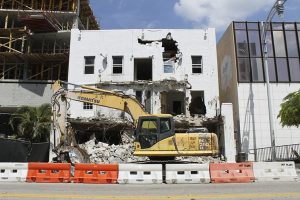
Phillip Pessar‘s Flickr stream reads like a love letter to Miami. In roughly 9,600 photos, it tells the story of South Florida’s ever-changing architectural landscape.
The photos are simple — many of them head-on shots of old department stores, abandoned burger joints, historic hotels, and bulldozed office buildings. There are no fancy editing tricks or filters, just straightforward photography. Every day, almost without fail, new pictures are added. And all consist of the same thing: images of Miami and South Florida architecture in various stages of decay, disarray, remodeling, or rebuilding.
Though Pessar’s photographs might be unremarkable, he has found a niche cataloging the mundane and quotidian: a bankrupt Radio Shack location, a Wet Seal store going out of business, an Airstream trailer outfitted into a food truck.
Oddly, he doesn’t consider himself a photographer.
“Look, I’m not an artistic photographer, and I don’t try to be,” the 58-year-old says. “I just put the camera on automatic and hope for the best.”
In other words, Pessar isn’t taking these photos for art’s sake. He’s taking them to capture Miami’s fleeting history and for documentary purposes. “It all boils down to taking snapshots,” he explains. “I’m trying to keep the memory of the few things that are left in South Florida that have been here for 40 years but are disappearing little by little.”
In fall 2005, Hurricane Wilma wreaked havoc on South Florida. The power was out in Pessar’s west Miami neighborhood, so he headed downtown every morning to use the computers at the public library. He needed internet access to keep up-to-date with his stocks and investments because that was how he made his money. Pessar is fuzzy on the details, but somehow, after spending hours walking around downtown and waiting for the bus (he doesn’t drive because of a childhood car accident), he decided to buy a disposable camera.
Once power was restored on his block, Pessar stopped going downtown, but he continued taking pictures. He upgraded to a Polaroid camera he bought from Urban Outfitters and started shooting buildings in Miami Beach. From there, he began buying old film cameras from thrift stores and experimenting with them. Though his equipment changed, his subjects never wavered.
“I love architecture,” says the Miami native, who inherited a Brooklyn accent from his father. “But truth be told, it’s the old retailers and fast-food places and roadside architecture that are my number one love.”
Pessar says he particularly enjoys shooting anything kitschy, retro, old, ugly, or abandoned. Art deco and midcentury buildings make up the bulk of his photographs, and he’ll snap them even if they’re falling apart, being demolished, or have been repurposed as another business. He says it’s the history of the buildings that keeps his hobby exciting — he never knows what old relic he may find, let alone what the building might be used for now.
On a typical day, Pessar wakes up at 7 a.m., drinks a cup of green tea, eats a light breakfast, and heads out the door by 8:30. If the sky is sunny, he’ll pack a couple of cameras — a film and a digital — and head for the bus stop. If he plans to take photos in a rough part of town, he’ll ride the Eight downtown, where he’ll meet up with his homeless buddies — friendships he’s cultivated since he began photographing Miami — and ask if they want to tag along for the excursion. “They’re guys I can trust,” he explains. “It’s a help to me, especially if I’m going to a really sketchy neighborhood and I don’t want to go alone.”
In fact, “the sketchier neighborhoods” are the best ones to visit, he says, because it’s like a scavenger hunt. “Those kinds of neighborhoods haven’t knocked everything down to build a brand-new McDonald’s. That’s where you’re going to find the cool old fast-food restaurants that have been long abandoned and the old Dairy Queens and the cool Carvels that they used to build in the ’50s.”
Not even Pessar’s friends understand his photography hobby. “They don’t get it,” he says. “Most people think I’m crazy.” Much of his support comes from online — people on Tumblr reposting his photos, Twitter comments, and Flickr followers. “It’s nice because I get a lot of feedback,” he says. “Evidently, there are a lot of people who are into it.” For instance, he’ll hear from people who no longer live in Miami or who vacationed in Miami and are glad to see photos of the places they visited. And, of course, there are always those who enjoy his photos for the trips down memory lane. “I get a lot of that kind of thing — people saying, ‘Oh, I remember shopping there or my mom taking me there as a kid.’?”
Lately, Pessar has also been taking photographs of newer buildings, such as the clothing stores Caché and Wet Seal, which are going out of business. These buildings too, he realized, will someday become part of history. “Since I was taking pictures of older retail,” he says, “new retail that’s going to be gone soon, you know, that’s kind of along the lines of what I do too.”
